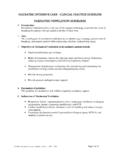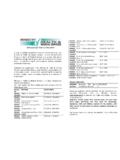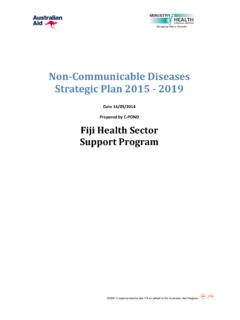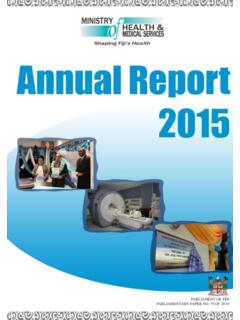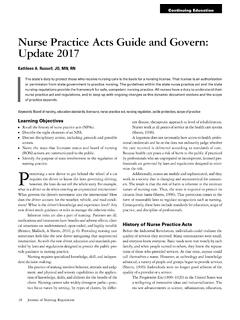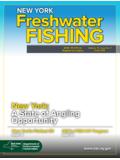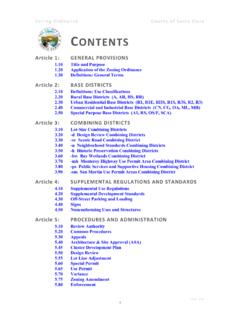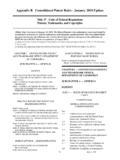Transcription of Food Safety Regulations 2009 - Ministry of Health and ...
1 Food Safety Regulations 2009 FIJI ISLANDS _____ [LEGAL NOTICE NO. 20] FOOD AND Safety ACT 2003 (NO. 10 OF 2003) _____ FOOD Safety Regulations 2009 Table of Contents PART I PRELIMINARY 1. Citation and commencement 2. Purpose 3. Interpretation PART II RELATIONSHIP TO CODEX ALIMENTARIUS 4. Standards 5. Product definition 6. Sampling 7. Applying HACCP PART III SAMPLING AND ANALYSIS 8. Procedure for taking samples for physical or chemical analysis when only one sample is required and division of sample is possible 9. Procedure for taking samples when one or more sample is required and division of sample is considered not possible or appropriate 10. Number of samples to be taken 11. Label for food sample and request for analysis 12. Analysis 13. Sampling and analysis for export PART IV 13 GOOD HYGIENIC PRACTICES 14. Obligations of food business operators regarding good hygienic practices 15.
2 Specific hygienic practices for businesses producing, processing and/or distributing fish and fisheries products 16. Specific hygienic practices for businesses producing, processing and/or distributing fish and fisheries products 17. Specific hygienic practices for milk and milk products 18. Specific hygienic practices for meat and meat products 19. Specific hygienic practices for egg and egg products 20. Good hygienic practices in the storage and transport of edible fats and oils in bulk PART V LABELING RULES AND PACKAGING 21. General requirements in labelling 22. Requirements on nutrient content labelling 23. Presentation of mandatory labelling 24. Prohibited claims 25. Use of nutrient content claims, nutrient comparative claims, nutrition claims and Health claims 26. Packaging PART VI FOOD ADDITIVES AND NUTRIENT SUPPLEMENTS 27. Food additives 28. Nutrient supplements PART VII INCIDENTAL CONSTITUENTS 29.
3 General limits on contaminants 30. Specific limits on chemical contaminants 31. Mycotoxins 32. Pesticide residues 33. Veterinary drug residues 34. Microbiological criteria PART VIII COMMODITY STANDARDS 35. Milk and milk products 36. Meat and meat products 37. Poultry, poultry products, eggs and eggs products 38. Fish and fisheries products 39. Edible fats and oils 40. Fruits, vegetables and their products 41. Cereal and cereal products 42. Sugars and honey 43. Spices and salt 44. Beverages 45. Food for infants and other vulnerable populations 46. Miscellaneous other foods PART IX LICENSES 47. Premises engaged in food business operations PART X AUTHORIZED OFFICERS AND INSPECTIONS 48. Qualifications of authorized officers 49. Frequency of inspections 50. Costs of inspections undertaken in respect of re-inspection for non-compliance PART XI OFFENCES, PENALTIES AND PUBLICATION OF OFFENDERS 51.
4 Offences and penalties 52. Publication of names of offenders PART XII REVOCATION 53. Revoking of Pure Food Regulations FIRST SCHEDULE LABEL FOR FOOD SAMPLE SECOND SCHEDULE REQUEST FOR ANALYSIS OF FOOD SAMPLE THIRD SCHEDULE ANALYST CERTIFICATE FOURTH SCHEDULE STANDARD ON GENERAL REQUIREMENTS ON GOOD HYGIENIC PRACTICES FOR ALL FOOD BUSINESSES FIFTH SCHEDULE STANDARD ON SPECIFIC REQUIREMENTS FOR FOOD BUSINESSES INVOLVED IN PRODUCING, PROCESSING AND DISTRIBUTING LOW-ACID AND ACIDIFIED LOW-ACID FOODS SIXTH SCHEDULE STANDARD ON SPECIFIC GOOD HYGIENIC PRACTICES FOR FISH AND FISHERIES PRODUCTS SEVENTH SCHEDULE STANDARD ON GOOD HYGIENIC PRACTICES FOR MILK AND MILK PRODUCTS EIGHT SCHEDULE STANDARD ON GOOD HYGIENIC PRACTICES FOR MEAT AND MEAT PRODUCTS NINTH SCHEDULE STANDARD ON SPECIFIC GOOD HYGIENIC PRACTICES FOR EGG AND EGG PRODUCTS TENTH SCHEDULE TABLE OF CONDITIONS FOR NUTRIENT CONTENT CLAIMS ELEVENTH SCHEDULE A.
5 MAXIMUM PERMITTED LEVELS OF CHEMICAL CONTAMINANT B. MYCOTOXINS TWELFTH SCHEDULE MAXIMUM LIMITS ON MICROBIOLOGICAL CONTAMINANTS IN FOODS THIRTEENTH SCHEDULE STANDARDS ON MILK AND MILK PRODUCTS Standard on milk Standard on fermented milks Standard on evaporated milk Standard on sweetened condensed milk Standard on cream Standard on milk powders and cream powders Standard on cheese Standard on processed cheese and spreadable processed cheese Standard on milkfats and ghee Standard on ice cream FOURTEENTH SCHEDULE STANDARDS ON MEAT AND MEAT PRODUCTS Standard on canned corned beef Standard on canned luncheon meat Standard on sausages Standard on minced meat or sausages labelled or advertised in such a way as to reference the fat content of the meat or sausage Standard on canned meat with other food Standard on smoked meat FIFTEENTH SCHEDULE STANDARDS ON POULTRY AND POULTRY
6 PRODUCTS, EGGS AND EGG PRODUCTS Standard on turkey tails and other poultry tails Standard on fluid loss from thawed poultry Standard on eggs SIXTEENTH SCHEDULE STANDARDS ON FISH AND FISHERIES PRODUCTS Standard on fresh fish and fish products Standard on canned tuna and bonito Standard on canned sardine and sardine-type products Standard on canned mackerel Standard on canned finfish Standard on frozen fish and fisheries products Standard on frozen shrimps or prawns Standard on smoked fish SEVENTEENTH SCHEDULE STANDARDS ON EDIBLE FATS AND OILS Standard on vegetable oils Standard on olive oils and olive-pomace oils Standard on animal fats Standard on butter Standard on dairy fat spreads Standard on fat spreads and blended spreads Standard on edible fats and oils not addressed in other Standards EIGHTEENTH SCHEDULE STANDARDS ON
7 FRUITS AND VEGETABLES AND THEIR PRODUCTS Standard on fruit Standard on fruit juices and nectars Standard on pickled fruits and vegetables Processed tomato concentrates Standard on jams and jellies Standard on marmalade Standard on ginger Standard on canned vegetables Standard on noni juice Standard on fruit and vegetable products not covered under other commodity Standards Dried fruit Mixed dried fruit Frozen fruit Candied fruit, glazed fruit and crystallized fruit Canned fruit Canned fruit cocktail Chutney NINETEENTH SCHEDULE STANDARDS ON CEREAL AND CEREAL PRODUCTS Standard on instant noodles Standard on rice Standard on wheat flour TWENTIETH SCHEDULE STANDARDS ON SUGARS AND HONEY Standard on sugars Standard on honey TWENTY-FIRST SCHEDULE STANDARDS ON SALT AND SPICES Standard on salt and reduced sodium salt mixtures General standard on spices and aromatic plants Standard on specific compositional requirements for spices TWENTY-SECOND SCHEDULE STANDARDS ON BEVERAGES Standard on packaged water (other than natural mineral waters)
8 Standard on packaged natural mineral waters TWENTY-THIRD SCHEDULE STANDARDS ON FOOD FOR INFANTS AND OTHER VULNERABLE POPULATIONS Standard on infant formula TWENTY-FOURTH SCHEDULE STANDARDS ON MISCELLANEOUS FOODS General requirements for canned food Standard on nuts TWENTY-FIFTH SCHEDULE APPLICATION FOR A Health LICENSE AND/OR RENEWAL OF A Health LICENSE IN RESPECT OF A FOOD BUSINESS OPERATION TWENTY-SIXTH SCHEDULE FEE FOR FOOD BUSINESS OPERATIONS Health LICENSE TWENTY-SEVENTH SCHEDULE FORM OF FOOD BUSINESS OPERATIONS Health LICENSE TWENTY-EIGHT SCHEDULE MINIMUM NUMBER OF PLANNED INSPECTIONS PER YEAR FOR GIVEN PREMISES TWENTY-NINTH SCHEDULE SAMPLING ACCORDING TO RISK AND LOT SIZE (TO BE USED WHERE NO OTHER SAMPLING GUIDANCE IS PROVIDED) _____ FOOD AND Safety ACT (NO. 10 OF 2003) _____ Food and Safety Regulations 2009 In exercise of the powers conferred upon the Board by section 70 of the Food Safety Act 2003, the Board makes these Regulations - PART I PRELIMINARY Citation and commencement (1) These Regulations may be cited as the Food Safety Regulations 2009.
9 (2) These Regulations come into force on the day it is published in the Gazette. Purpose 2. The purpose of these Regulations is to protect the Health of the public and to protect the consumer against deception and from food of unacceptable and poor quality, by establishing minimum Standards on food products. These Regulations apply to food imported into, or produced and processed in Fiji for domestic consumption or export/re-export. Interpretation 3. In these Regulations , unless the context otherwise requires - "Act" means the Food Safety Act 2003; "Authorized officer" means a person who has the training, knowledge, skills and ability to perform an assigned task, and who is subject to requirements specified by these Regulations ; "Board" means the Central Board of Health constituted under section 3 of the Public Health Act (Cap 111); "Catering premises" means those premises where food is offered for immediate consumption, including but not limited to restaurants, canteens, schools, hospitals, hotels and similar institutions as well as mobile or temporary vendors (where permitted) of ready-to-eat food; "Claim" means any representation which states, suggests or implies that a food has particular qualities relating to its origin, nutritional properties, nature, processing, composition or any other quality.
10 "Competent Authority" means the official authority charged by the Board with the control of these Regulations . The national Competent Authority shall also be taken to mean a "food authority" under the Act. Not withstanding this definition, when the term "Competent Authority" is used in relation to the authority in another country to which Fiji is exporting or from which Fiji is importing, the Competent Authority shall be the official authority charged by that country to control imported or exported food; "Consumer" means persons and families purchasing and receiving food in order to meet their personal needs; "Container" means any packaging of food for delivery as a single item, whether by completely or partially enclosing the food and includes wrappers. A container may enclose several units or types of packages when such is offered to the consumer; "Date of Manufacture" means the date on which the food becomes the product as described; "Date of Minimum Durability" ("best before") means the date which signifies the end of the period under any stated storage conditions during which the product will remain fully marketable and will retain any specific qualities for which tacit or express claims have been made.



